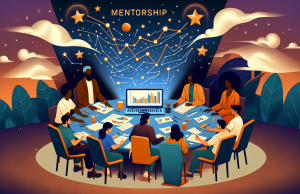As the sun sets on the careers of baby boomers, and the digital dawn heralds the arrival of Gen Z, the workplace has become an ever-evolving mosaic of ideologies, expectations, and communication styles. This divergence has given rise to what can be termed the ‘Mentorship Gap,’ a chasm that stretches between the experienced and the newcomers, often hindering the seamless flow of wisdom and experience necessary for a vibrant working environment.
The challenge is not merely to address this gap but to bridge it effectively. Mentorship programs offer a robust scaffold upon which this bridge can be built, fostering an ecosystem that values mutual growth and learning. These initiatives can catapult fresh-faced professionals into realms of understanding that might take years to achieve in isolation, while simultaneously offering veterans a refreshing dive into the pools of innovation and adaptability that characterize their younger colleagues.
To navigate the chasm, we must first recognize the diversity in learning and teaching preferences that span the generational spectrum. Traditional face-to-face mentorship is transforming, with technology as its catalyst. Virtual meetings, online learning platforms, and digital communication tools are reshaping the way knowledge is shared. Adopting these technologies can make mentorship more accessible and flexible, aligning with the dynamic lifestyle of today’s workforce.
Yet, the integration of these technological advancements must be approached with sensitivity to the varying comfort levels across generations. Some seasoned professionals might be reticent to shift from conventional methods, just as some younger mentees might crave the personal touch that digital means can sometimes lack. Companies must stride forward with a strategy that harmonizes these preferences – creating a culture that not only tolerates but celebrates continuous learning and knowledge transfer.
However, the path to an effective mentorship program is not without its pitfalls. Generational biases can taint perceptions, and resistance to new learning methods can stifle progress. Organizations must be vigilant in dispelling myths and prejudices that can sour the mentor-mentee relationship. Equipping participants with the right tools – such as bias training and conflict resolution techniques – can preempt these issues, ensuring that mentorship remains a productive and positive experience.
Real-world examples pepper the landscape with stories of success. Take, for instance, the multinational tech company that launched a ‘reverse mentoring’ program, wherein junior employees mentor senior executives on trends like social media and new technologies. This twofold approach not only upskills the older generation but also empowers the younger, instilling in them a sense of value and belonging.
By weaving together perspectives from HR professionals who architect these programs, executives who sponsor and participate in them, recent graduates who breathe fresh life into them, and retirees who, even in the twilight of their careers, seek to leave a lasting legacy – we witness a rich tapestry of insights on the transformational power of mentorship within the workplace.
In conclusion, the Mentorship Gap is a call to action for organizations to embrace the diversity of their workforce. By implementing effective, technology-driven mentorship programs that cater to the needs of a multigenerational team, we can foster an environment of inclusivity, learning, and professional development. These initiatives not only bolster organizational health and employee satisfaction but also serve as a testament to the enduring spirit of collaboration and shared wisdom that underpins the very concept of work, worker, and workplace.

















![From TAOLabs: A New, Simplified Way to Learn in the Age of Chaos [30m60h90d] From TAOLabs: A New, Simplified Way to Learn in the Age of Chaos](https://theworktimes.com/wp-content/uploads/2025/05/ChatGPT-Image-May-13-2025-01_11_22-AM-238x178.png)








